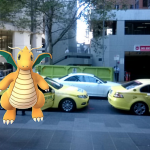 Purdue University - Extension - Forestry and Natural Resources
Purdue University - Extension - Forestry and Natural Resources
Got Nature? Blog
In August of 2016, we posted an article about how the online game Minecraft teaches forest regeneration and helps users understand the pros and cons of various tree species. This year, we bring you information about Pokémon GO a game designed for your smartphone. While the premise of the game is to find cute creatures to befriend and train for battle, this game ultimately teaches additional lessons about nature and conservation.
After being released July 6, 2016, popularity for Pokémon GO exploded around the globe. With more than 500 million downloads in the first two months, this mobile phone game has brought cartoon Pokémon from television to more children and adults than ever before. Virtual Pokémon on your mobile screen appear to be a part of your real-world environment. As you catch, train, and battle your Pokémon, lessons about natural history and conservation are being taught and absorbed without you being aware of it.
Playing Pokémon GO is akin to bird watching as these creatures exist as “real” animals found outdoors that can be caught and collected. In their efforts to catch rare species, more people are venturing outdoors and visiting parks and conservation areas. With the new interest in visiting the outdoors, interactions with ‘real’ animals in nature have also increased. The Twitter hashtag #Pokeblitz is a repository for photos of wildlife species observed during play.
Players learn basic concepts such as habitat preferences. For example, ‘Grass Pokémon’ are most often found in parks, forests, or conservation areas while water-types can be found nearest to water sources. In addition, lessons regarding native regions are also taught as some species can only be found in certain continental regions. The Pokémon ‘Tauros’, a bull with multiple tails, is native to the Americas, ‘Mr Mime’, humanoid fairy, to Western Europe, ‘Farfetch’d’, an aggressive duck-like creature, to Asia, and the marsupial-like ‘Kangaskhan’ to Australasia. The take-away lesson most players learn is that exploration of new areas and continents will yield new species.
Newly published research from scientists at Oxford, Cambridge, UNEP World Conservation Monitoring Centre, and the University College London (UCL) explored whether the game posed more problems for conservation efforts as gamers focused more on the virtual
than real animals or solutions to getting more people to explore the outdoors. They list pros and cons and their suggestions below:
The pros:
- More people are venturing outside and learning about nature
- There is a renewed interest in habitat conservation
- All you need is a smartphone
The cons:
- The brightly-colored and engaging Pokémon are not a true representation of actual wildlife
- Battling Pokémon in the game could encourage exploitation of ‘real’ animals.
Suggestions:
- Make the Pokémon more realistic (biology and ecology)
- Add real species to the Pokémon GO universe to raise awareness of these species
- Place Pokémon in more remote areas to draw people out of the cities
- Add a mechanism to catalogue real species to build upon #Pokeblitz
- Use Pokémon GO lessons to develop augmented reality (AR) games about real species and conservation efforts where users look for and catalog species for educational purposes.
If there were any doubts about the game’s popularity, hundreds upon hundreds of people converged in Central Park one night last summer in a contest to find the rare Pokémon ˈVaporeonˈ said to be inhabiting the park. A last thought from scientists was that true conservation efforts could wane as finding virtual species outweighs protecting endangered ˈrealˈ species. However, engagement efforts with the public regarding conservation can take notes from the responsive Pokémon as many current efforts are full of scientific terms and tend to be off-putting to a general audience. The popularity of Pokémon GO has implied that the public can be reached but we need other ways of relaying information that encourage additional learning.
Literature Cited:
Dorward LJ, Mittermeier JC, Sandbrook C, Spooner F. 2016. Pokémon Go: Benefits, Costs, and Lessons for the Conservation Movement. Conservation Letters doi: 10.1111/conl.12326.
Resources:
Can online gamin help improve your knowledge of forest trees?, Purdue Extension-FNR Got Nature?
Shaneka Lawson, USDA Forest Service/HTIRC Research Plant Physiologist/Adjunct Assistant Professor
Purdue University Department of Forestry and Natural Resources

Recent Posts
- Report Spotted Lanternfly – Purdue Landscape Report
Posted: April 10, 2024 in Alert, Forestry, Invasive Insects, Plants, Wildlife, Woodlands - Declining Pines of the White Variety – Purdue Landscape Report
Posted: in Alert, Disease, Forestry, Plants, Wildlife, Woodlands - Are you seeing nests of our state endangered swan? – Wild Bulletin
Posted: April 9, 2024 in Alert, Forestry, How To, Wildlife - Cicadas in Spring! – Purdue Landscape Report
Posted: in Forestry, Plants, Safety, Wildlife - New Deer Impact Toolbox
Posted: April 7, 2024 in Forestry, Land Use, Plants, Publication, Safety, Wildlife, Woodlands - 2024-25 Fishing Guide now available – Wild Bulletin
Posted: April 4, 2024 in Alert, Aquaculture/Fish, Aquatic/Aquaculture Resources, How To, Ponds, Wildlife - Help Research Chronic Wasting Disease – Wild Bulletin
Posted: April 3, 2024 in Disease, Forestry, How To, Safety, Wildlife, Woodlands - Indiana Reptiles and Amphibians – IFWOA Webinar
Posted: April 1, 2024 in Forestry, How To, Webinar, Wildlife, Woodlands - Birding through the Seasons – IFWOA Webinar
Posted: in Forestry, How To, Webinar, Wildlife, Woodlands - Look Out for Invasive Carp in Your Bait Bucket – Wild Bulletin
Posted: March 31, 2024 in Alert, Aquaculture/Fish, Aquatic/Aquaculture Resources, Invasive Animal Species, Wildlife
Archives
Categories
- Alert
- Aquaculture/Fish
- Aquatic/Aquaculture Resources
- Ask the Expert
- Christmas Trees
- Community Development
- Disease
- Drought
- Forestry
- Forests and Street Trees
- Gardening
- Got Nature for Kids
- Great Lakes
- How To
- Invasive Animal Species
- Invasive Insects
- Invasive Plant Species
- Land Use
- Natural Resource Planning
- Nature of Teaching
- Plants
- Podcasts
- Ponds
- Publication
- Safety
- Timber Marketing
- Uncategorized
- Urban Forestry
- Webinar
- Wildlife
- Wood Products/Manufacturing
- Woodland Management Moment
- Woodlands


